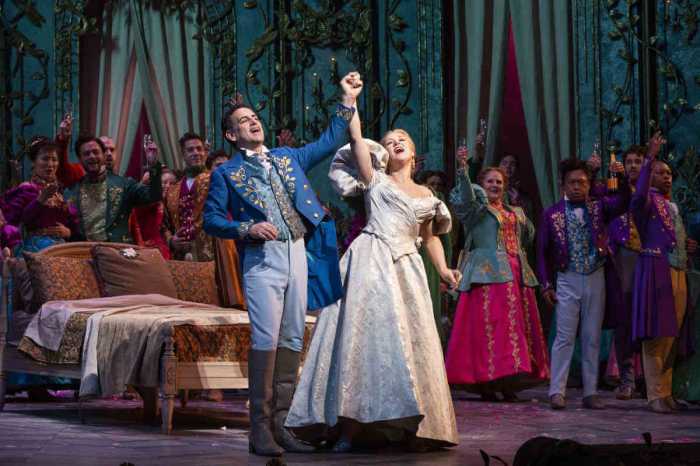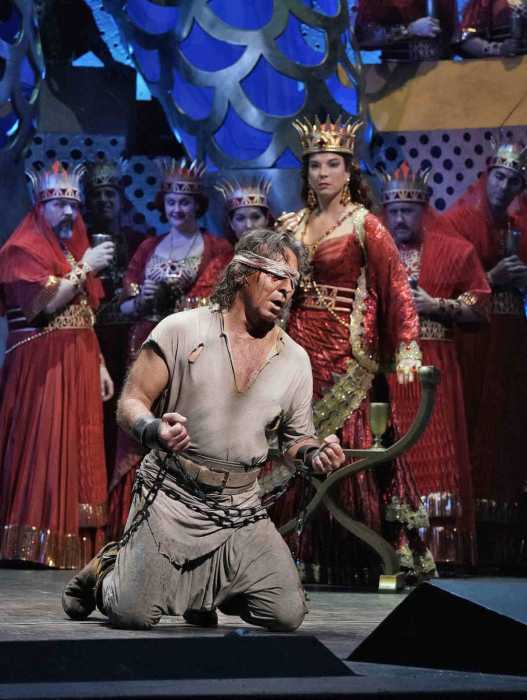Hei-Kyung Hong, who was honored at the December 8 intermission, in Puccini’s La bohème.” | CORY WEAVER/ METROPOLITAN OPERA
The Met production of “La bohème” dates from 1981; my database tells me I had seen it 15 times before going again December 8. Franco Zeffirelli’s behemoth concept of Act II – an audience “set applause” machine rendering the principals all but invisible – is usually balanced by the wintry beauty of Act Three. On this occasion the lighting was off and one could not see behind the rear scrim to the Pissarro-like angled road up and down which several figures enter and depart.
Revival director J. Knighten Smit kept the bohemians’ “hijinks” from being cringeworthy, though Act Four’s dancing riffs fell pretty flat. Marco Armiliato, whose name used to guarantee a certain degree of base-line mastery in the pit, seems sadly to have slipped into dulled routine. Those performers who made an impact did so almost despite him.
The evening’s chief interest was the fine Mimi of Hei-Kyung Hong, now 32 years into a Met career marked by superior vocalism and quiet musical artistry. Looking slim and lovely, Hong offered beautifully phrased lyric singing – with somewhat less body on bottom notes than before, but true and floating on high. A class act, as ever. At the intermission, general manager Peter Gelb honored her devoted service with a costume sketch for the “Figaro” Countess, joined to a photo of her wearing it.
Hei-Kyung Hong, Piotr Beczala in Met’s “Bohème”; “La clemenza di Tito” at Manhattan School
Piotr Beczala, one of the world’s great Rodolfos, proved in uneven form: stirring at best but with odd lapses in vocal production and amount of tonal juice. He did partner Hong considerately, except maybe for taking the unwritten high C after they exited in Act One.
Sadly, the Musetta/ Marcello pairing was the weakest I’ve ever heard at the Met, a far cry from the phenomenal Anna Netrebko/ Peter Mattei pairing offered in 2004. One shouldn’t write off any soprano on the basis of Musetta, but nothing Brigitta Kele did – in any of the different kinds of singing or drama Puccini gave her – bespoke any distinction. Massimo Cavalletti looked nice as Marcello but his baritone lacked steadiness and quality. Patrick Carfizzi surely outsings most of the world’s Schaunards; perhaps bored, he should guard against putting too many squeaks and guffaws into the mix. Ryan Speedo Green was a solid, affable Colline until his Coat Song, which he delivered with more precise phrasing and deeper feeling. Paul Plishka, who joined the company in 1967, came welcomely out of retirement to do — well — the two comic turns, Benoit and Alcindoro.
Manhattan School of Music presented Mozart’s “La clemenza di Tito” with two alternating casts December 8-11. Dona Vaughn’s production was a model of presenting a tricky historical opera seria simply but with color and flow.
Erhard Rom’s faux marble-and-pillars set and Tracy Dorman’s handsome costumes suggested a stately, powerful Rome divided only by the personal passions unleashed in the libretto’s plot. Follow spots sometimes flickered, but otherwise Tyler Micoleau’s lighting provided atmosphere for chaos and triumph alike. George Manahan obtained fine — if sometimes testingly swift – results from the orchestra, especially the crucial clarinets and oboes, and Miriam Charney’s chorus handled itself commendably.
Everyone in both casts showed some talent, even if different levels of achievement and suitability for Mozart opera seria were perforce on exhibit. Saturday’s cast, in general higher profile dramatically, coalesced around the extraordinarily adroit, layered characterization of Vitellia by Abigail Shapiro; Sunday’s performance revolved around Marie-Gabrielle Arco’s long-suffering but noble Sesto. Shapiro really went for Vitellia’s demented pride and self-focus, finding almost two different voices to handle the notoriously lowering-as-it-goes tessitura. Her Sunday counterpart Yeon Jung Lee sang well, with more conventional unity of registers, but was not as specific. Hongni Wu, with an aptly androgynous timbre for a castrato role, sang Sesto’s runs with amazing fluidity; Arco, who looked far more like a young man, fielded a rounder, warmer tone.
The two Annios – Amy Yarham and Alanna Fraize – both showed promising, nice voices not yet fully reliable technically. Both Servilias – Hayan Kim and Jianing Zhang – looked lovely and sang “S’altro che lagrime” with melting beauty. In Publio’s limited duties, Michael Gracco showed evener, more musically integrated vocalism and Liang Zhao more bass resonance.
Mozart wrote Tito – a fiercely demanding role technically for his first Ottavio, Antonio Baglioni. I’ve only ever heard four good ones live: Richard Croft, Frank Lopardo, Ramón Vargas, and Matthew Polenzani, all front-rank mature professionals — and it’s not a part many conservatories could cast. Neither young tenor moved or declaimed with the assurance of a warrior emperor. Credit Philippe L’Esperance’s pleasant, light Bach/ Handel-type voice with remarkable agility and clarity. Surely Wooyoung Yoon’s larger, baritonal timbre points more toward Wagner’s Froh or Slavic rep; he coped better with the final ensemble than with the near-impossible “Se all’impero.”
MSM’s next mainstage gig is Johann Strauss’s “Gypsy Baron” April 27-30.
David Shengold (shengold@yahoo.com) writes about opera for many venues.



































